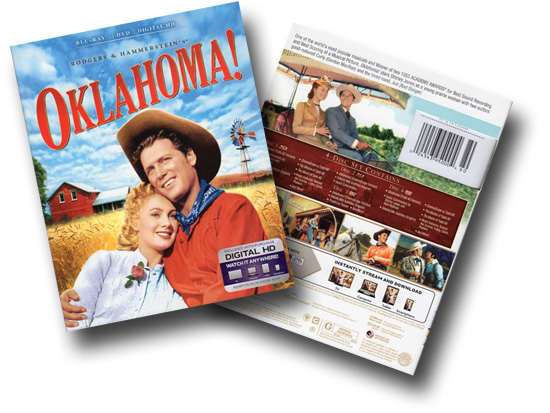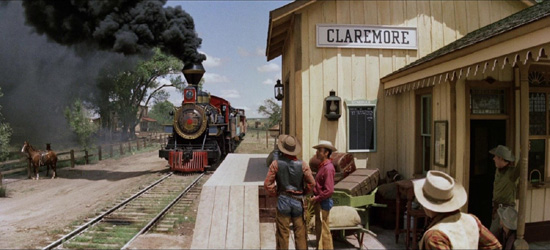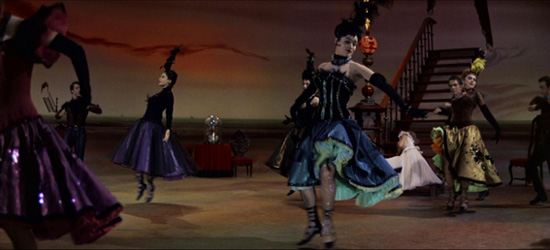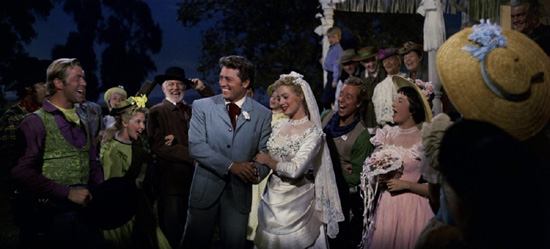The Restoration of Oklahoma! on Blu-Ray |
Read more at in70mm.com The 70mm Newsletter |
| Written by: Paulo Roberto P. Elias, Rio de Janeiro, Brazil | Date: 01.01.2015 |
 It is perhaps by sheer coincidence that movie and home theater buffs
have been demanding more quality in the final releases of classic films on
home video formats while at the same time archivists and restorators are
continuously revising lab work concepts, due to the improvements that have
been achieved in restoration tools and resources. It is perhaps by sheer coincidence that movie and home theater buffs
have been demanding more quality in the final releases of classic films on
home video formats while at the same time archivists and restorators are
continuously revising lab work concepts, due to the improvements that have
been achieved in restoration tools and resources.After the Blu-Ray era started we have seen examples of vintage films being subjected to new and sometimes revolutionary recovering methods, as to justify the improvement of the video medium itself. 1920 x 1080p may not be good enough for current resolution standards, but the fact is that a significant number of Blu-Ray releases depict conclusive evidence that the medium is still a competent way to appreciate restoration efforts done in the lab. |
More in 70mm reading: The (most anticipated) restoration of the Todd-AO feature Oklahoma A restauração do clássico Todd-AO “Oklahoma” Fred Zinnemann's "Oklahoma!" in Todd-AO Internet link: |
 The
reader will see the equivalent of the already
published
DVD capture, but with the improvements accomplished by the new restoration. The
reader will see the equivalent of the already
published
DVD capture, but with the improvements accomplished by the new restoration.Enter Oklahoma! on Blu-Ray now, and collectors may still remember the two disastrous previous DVD editions, one with the film carelessly transferred to an outdated format (4:3 letterbox), and the other to an anamorphic picture quality that is so blurred and soft that is unbearable to watch. Please note that we are not talking just about any film. Oklahoma! has been historically identified by its association with the Todd-AO filming process, as the very first shot with lenses developed by American Optical designed to realize the Cinerama curved screen off one single film frame and projector. |
|
 The current Blu-Ray release will prove that the restoration done for
Oklahoma! was indeed first rate. The current Blu-Ray release will prove that the restoration done for
Oklahoma! was indeed first rate.This is the “flat” version of the camera frame, as captured by spherical lenses lacking the usual anamorphic distortion of other widescreen releases. The sharpness and increased depth of focus of the picture that can be noticed is also a bonus in the magnitude of the field of vision achieved by the Todd-AO format. More importantly, the new restoration manages to put the colour balance back into the film. Hues and saturation are retrieved in perfect harmony, to the extent of making the picture look like new. |
|
The Restoration Process |
|
 TV
screen with a scene from "Oklahoma!" TV
screen with a scene from "Oklahoma!"The secret to restore audio or film analogue sources in the digital domain relies on the accuracy of the algorithms written for the cleaning tools and other resources. To help the massive amount of calculations that must be performed by these programs it is advisable to transfer the analogue sources to the highest resolution possible. Film elements of this gauge are successfully transferred to an 8K master, which will be used for restoration. When the work is finished, a Digital Intermediate at 4K resolution is made and used subsequently to provide whatever digital medium the source will be intended for. FotoKem reported that the original camera negative had faded to the point of not being usable for a reasonable restoration effort. Instead, they used a 65 mm interpositive (IP) copy struck from the original and already faded negative years ago. According to the technicians involved this IP would provide the photographic information that was necessary to recover the original negative, after an 8K copy that was done using an Imagica scanner, fitted with a wet gate. Picture artefacts, such as flickering and “colour breathing” were subsequently removed, but fortunately very little of the grain was taken out. Colour timings and further adjustments that were done did not compromise the integrity of the final copy, as can be observed in the Blu-Ray version. |
|
 Oklahoma! was partially shot in soundstages, with presumably controlled
lighting. In the Blu-Ray transfer it is easy to see how defined these
sequences are, with no signs of black crush or lack of low detail picture
information. Oklahoma! was partially shot in soundstages, with presumably controlled
lighting. In the Blu-Ray transfer it is easy to see how defined these
sequences are, with no signs of black crush or lack of low detail picture
information.Colour temperature in artificially lighted scenes is overall excellent. Whites are as natural as they should be. In order to make the Blu-Ray version as faithful as possible to the film’s original cadence of 30 fps, Oklahoma! was transferred in 1080i 30 Hz. Most playback systems will, nevertheless convert the video signal to 1080 p 60 Hz, or to 2160p 30 Hz in 4K sets. Fox released Oklahoma! as part of the Rodgers-Hammerstein box set and in a separate set of 4 discs. The Todd-AO and CinemaScope versions were transferred to two different Blu-Rays and DVDs. The latter posed no problems when the last DVD release was made, but it was transferred to Blu-Ray with much better quality. |
|
 Title
card for "The Miracle of Todd-AO" also included in the Blu-ray. Title
card for "The Miracle of Todd-AO" also included in the Blu-ray.The soundtrack of the Todd-AO version was coded into a DTS HD MA 7.1 track, from the 6-channel master. Given that Todd-AO had 5 channels behind the screen no perceivable effort was made to keep the dialogues as directional as possible. In fact, most of it was kept in the centre channel, as a normal modern film. There is no harm in transferring the 6-channel Todd-AO sound source to 7.1, but at the same time it is not radically necessary, because the music score is fully front stage and can only benefit of the surround and back channels for ambience. |
|
 Title
card for "The March of Todd-AO" also included in the Blu-ray. Title
card for "The March of Todd-AO" also included in the Blu-ray.The CinemaScope sound track has a more realistic DTS HD MA 4.0 track. The sound quality of this track is quite good, but surely not on a par with the Todd-AO version, in my opinion. Since both shootings were for the most part slightly different I believe that movie buffs will stick to the Blu-Ray containing the Todd-AO film, now that it has been completely recovered from the DVD disasters. There are two Todd-AO shorts, namely "The Miracle of Todd-AO" and "The March of Todd-AO", which had been included in the last DVD edition. The first one is was aded to "Oklahoma!" screenings in May 1956. None of them were subjected to the same restoration as the main feature, showing an overall quite soft picture. It is not as offensive as we’ve seen before but surely not on a par with the new presentation of the film. Finally, it is noteworthy to mention that current 4K upscaling TVs or Blu-Ray players will produce the best picture quality for this release that has been seen in recent years as far as other Todd-AO Blu-Ray editions are concerned. |
|
| Go: back - top - back issues - news index Updated 22-01-25 |
